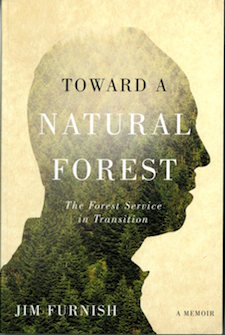Toward a Natural Forest: the Forest Service in Transition (a Memoir)
Last Updated on November 21, 2022 by

by Jim Furnish
ISBN 978-0-87071-813-7
Oregon State University Press, Corvallis, OR, 2015
“The forest battle between commerce and protection is an old one.” Which should be more important on public lands, resource extraction or resource protection? In his recent memoir, Jim Furnish relates his 37 years in the Forest Service, starting in Tiller, Oregon in 1965. He shares how his perspective on managing forests changed from maximum production to forest stewardship.
Furnish presents the three main phases of Forest Service history: custodial care, utilitarian extraction (maximizing timber yield), and ecosystem management. He then describes the evolution of his personal ethics of conservation and the conflicts that arose among Forest Service employees at all levels during the transition to the third phase and between the agency and its user groups (environmentalists and timber companies).
The book comprises eleven chapters; the first ten chapters are organized by the locations where he worked, with chapter titles summarizing the content of each time frame. Furnish spent his foundational years conducting forest inventories in Maine. “A Dream Realized” describes his years as a forester in the Black Hills National Forest in South Dakota. In “A Rookie Ranger,” Furnish has been promoted to District Ranger in the Bighorn National Forest in Wyoming. In “Redemption and Revelation,” he writes about the work he did in the San Juan National Forest in Colorado reviewing timber plans and cofounding the San Juan Association, a nonprofit that enhanced tourism in the region. In this job, he realized that, “In practice, forest plans served as an anvil where sparks flew to ignite intractable disputes rather than being a crucible for credible compromise.”
One of the stepping stones to upper level management in the Forest Service is time spent in Washington, DC, where Furnish worked from 1989 to 1991, reviewing environmental groups’ appeals to forest plans. He also participated in a team tasked with reviewing the issues causing internal conflicts in the Forest Service and with making suggestions about how to proceed. This team’s report, New Perspectives, was changed to ecosystem management because that better described the thrust of the new perspectives.
“You can plant all the trees you want, but you can’t make a forest.” Furnish returned to Oregon, and from 1991 to 1999 served first as deputy forest supervisor, then forest supervisor of the Siuslaw National Forest. Headquartered in Corvallis, he oversaw research on stand thinning experiments since clearcutting was no longer supported by the public. In chapters 6 and 7, “Intractable Conflict” and “From Despair to Hope,” he writes about dealing with controversies about roads, reduced logging, elk habitat, stream erosion, and salmon recovery on the Siuslaw.
Chapters 8-10 cover Furnish’s second sojourn at Forest Service headquarters in Washington, DC, from 1999-2002. Although he writes about Forest Service politics throughout the book, here he highlights national politics outside and within the Forest Service. Furnish and his colleagues were under a lot of pressure to develop and articulate new policies before Clinton’s successor took office. In the final chapter, “A Green Manifesto and Our Future,” Furnish recommends how we might become better stewards of the land, recognizing that forests are ecosystems that encompass not only trees, but other plants, soil, water, wildlife, and ecosystem processes, such as fire and insect outbreaks.
As an ecology graduate student in Oregon in the 1960s and 70s, I remember vast rafts of logs floating down the lower Siuslaw River and myriad unpaved, numbered logging roads in the Cascades. When I returned to Oregon 35 years later, I wondered what had happened to the logging economy and why. Jim Furnish’s memoir goes a long way to answering my questions. I also learned how the Forest Service is organized, how difficult the transition away from resource extraction was for the Agency, and the importance of his connections with his colleagues.
This book would interest plant lovers, individuals wanting a more in-depth look at the Forest Service, and Oregonians who want an insider’s view of the dramatic changes in forest stewardship. Furnish writes well and his story moves along at a good pace. I especially appreciated the lack of jargon, the Forest Service organizational structure diagram at the beginning of the book, and the map showing where Furnish worked during his career in the Forest Service. The book also contains 20 endnotes and an index.
—Mary Beth Averill, Emerald Chapter.
